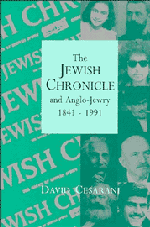Book contents
- Frontmatter
- Contents
- Preface
- Acknowledgements
- Introduction
- 1 Origins and pioneers, 1841–1855
- 2 Defining an identity: the Jewish Chronicle and mid-Victorian Anglo-Jewry, 1855–1878
- 3 The era of Asher Myers and Israel Davis, 1878–1906
- 4 The hegemony of Leopold Greenberg, 1907–1931
- 5 Discordant interlude: J. M. Rich and Mortimer Epstein, 1932–1936
- 6 Ivan Greenberg and the crisis years, 1937–1946
- 7 The post-war era: J. M. Shaftesley and David Kessler, 1946–1958
- 8 The Jewish Chronicle under William Frankel, 1958–1977
- 9 The Jewish press in a divided community: Geoffrey Paul, 1977–1990
- Conclusion
- Notes
- Bibliography
- Index
- Plate section
- Frontmatter
- Contents
- Preface
- Acknowledgements
- Introduction
- 1 Origins and pioneers, 1841–1855
- 2 Defining an identity: the Jewish Chronicle and mid-Victorian Anglo-Jewry, 1855–1878
- 3 The era of Asher Myers and Israel Davis, 1878–1906
- 4 The hegemony of Leopold Greenberg, 1907–1931
- 5 Discordant interlude: J. M. Rich and Mortimer Epstein, 1932–1936
- 6 Ivan Greenberg and the crisis years, 1937–1946
- 7 The post-war era: J. M. Shaftesley and David Kessler, 1946–1958
- 8 The Jewish Chronicle under William Frankel, 1958–1977
- 9 The Jewish press in a divided community: Geoffrey Paul, 1977–1990
- Conclusion
- Notes
- Bibliography
- Index
- Plate section
Summary
In the late eighteenth century, the press in England was limited to a few London dailies and evening papers that appeared two or three times a week, along with a vibrant provincial weekly press. However, the decades between 1780 and 1820 saw a sudden spurt of publishing activity. In 1781, there were 76 newspapers in England and Wales; by 1821 the number had risen to 267, and it had almost doubled again to reach 563 thirty years later. This expansion followed advances in popular education and the increasing urbanisation of English society. The towns and cities that burgeoned in the course of the Industrial Revolution created a large market for periodicals as well as demand for the advertising necessary to make journals viable.
The growth of the press was also facilitated by technological developments such as the Stanhope press in 1800, the Koenig steam press in 1814 and the rotary cylinder press from the 1850s onwards, which made it possible to print more copies faster at a reduced cost. In addition, the distribution and marketing of newspapers was steadily improved by the use of mail coaches and then the railways. However, machinery was enormously expensive, and newspapers had heavy overheads due to the cost of paper, telegraphy and large, expensive teams of reporters. The taxes on paper, advertising and newspapers added to the difficulties of making them profitable.
- Type
- Chapter
- Information
- The Jewish Chronicle and Anglo-Jewry, 1841–1991 , pp. 1 - 7Publisher: Cambridge University PressPrint publication year: 1994



